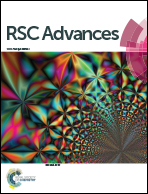Microwave-assisted methylation of dihydroxybenzene derivatives with dimethyl carbonate†
Abstract
Using a focused microwave reactor, methylation with dimethyl carbonate (DMC) of 1,2- and 1,4-dihydroxybenzene derivatives, found in the product spectrum of lignin depolymerisation, leads to the respective aromatic bis-methyl ethers with excellent isolated yields. Stoichiometric as well as catalytic amounts of 1,8-diazabicyclo[5.4.0]undec-7-ene (DBU) are effective for the bis-methylation of these dihydroxybenzenes at relatively mild temperatures (160–190 °C). Conversion of resorcinol (1,3-dihydroxybenzene) under similar conditions leads to a mixture of 1,3-dimethoxybenzene and methyl 2,4-dimethoxybenzoate. The unusual reactivity of resorcinol's phenyl ring towards DMC can be explained by the synergic effect of its two strongly activating ortho/para directing groups.



 Please wait while we load your content...
Please wait while we load your content...